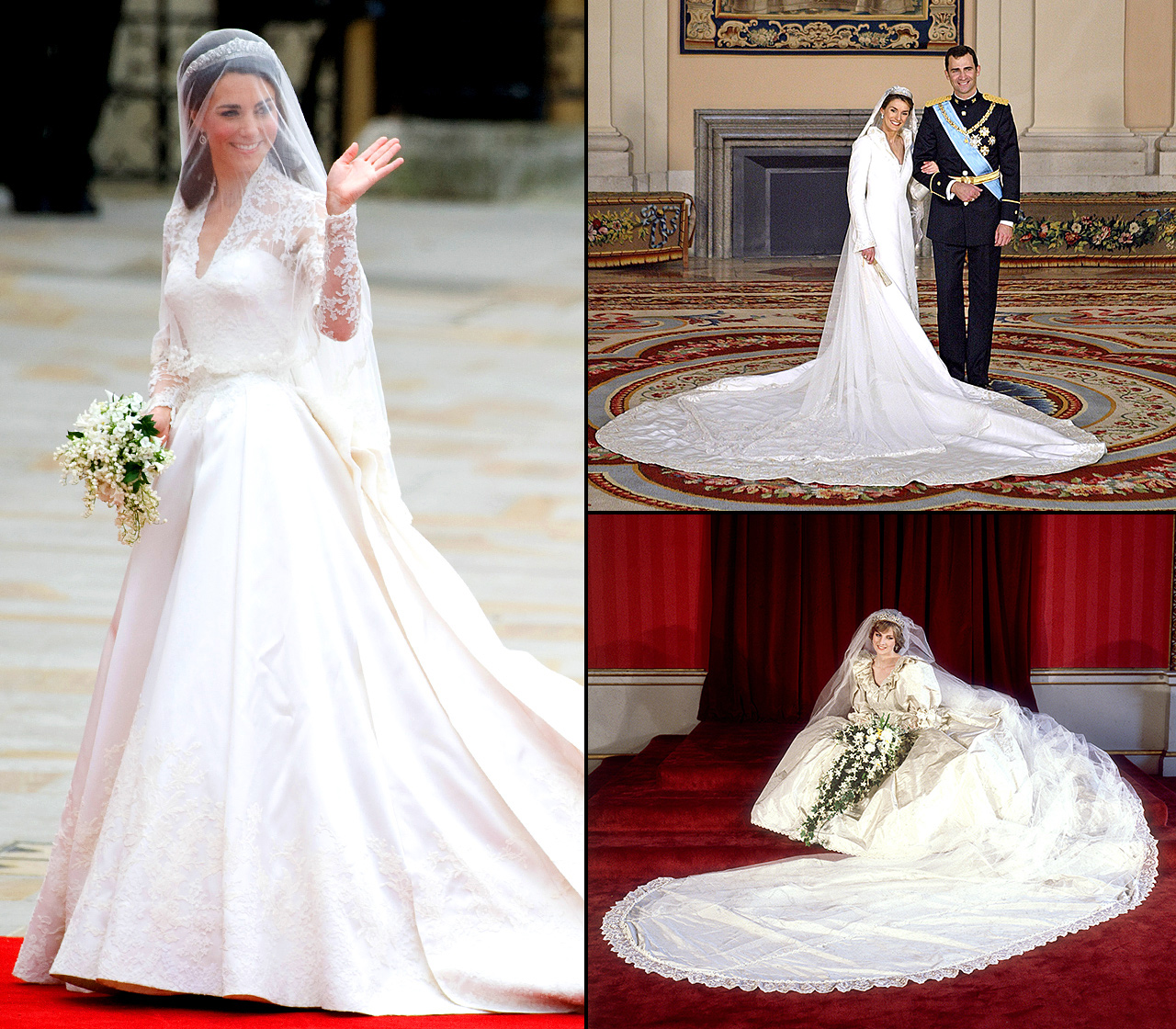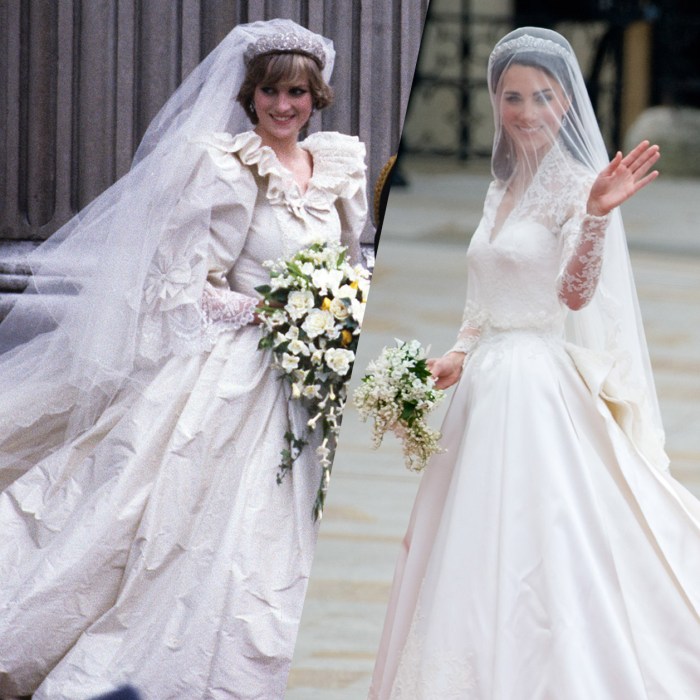Historical Overview of Royal Wedding Dresses

Source: usmagazine.com
Wedding dresses of the royal family – Royal wedding dresses have evolved significantly throughout history, reflecting changing social norms, fashion trends, and the personal styles of the brides. From simple gowns to elaborate creations, these dresses offer a fascinating glimpse into the past and the evolving role of women in royal families.
Evolution of Royal Wedding Dress Styles
The styles of royal wedding dresses have mirrored broader fashion trends, yet maintained a certain level of formality and grandeur befitting their status. Early royal wedding gowns often featured simple silhouettes and fabrics, gradually becoming more ornate and elaborate over the centuries. The introduction of new technologies and design innovations further shaped the evolution of these iconic garments.
| Era | Royal Couple | Designer (if known) | Notable Features |
|---|---|---|---|
| Victorian Era | Queen Victoria & Prince Albert | Unknown | Honiton lace, simple silhouette, white dress (establishing a trend) |
| Edwardian Era | Queen Mary & Prince George | Unknown | Elaborate embroidery, high neckline, long sleeves |
| 1920s | Princess Mary & Henry Lascelles | Unknown | Dropped waistline, beaded embellishments, Art Deco influence |
| 1950s | Queen Elizabeth II & Prince Philip | Norman Hartnell | Full skirt, ivory satin, intricate embroidery, post-war optimism |
| 1980s | Princess Diana & Prince Charles | David & Elizabeth Emanuel | Puffed sleeves, voluminous skirt, antique lace, iconic status |
Designers and Their Impact
Many renowned designers have contributed to the legacy of royal wedding gowns, each bringing their unique aesthetic and design philosophy to the task. Their creations have not only reflected the brides’ personalities but have also influenced broader fashion trends and perceptions of royal style.
Iconic Royal Wedding Dresses and Their Designers
- Queen Elizabeth II: Norman Hartnell – A classic, elegant design that embodied post-war optimism.
- Princess Grace of Monaco: Helen Rose – A simple yet elegant gown that defined Hollywood glamour.
- Princess Diana: David & Elizabeth Emanuel – A dramatic, romantic gown that remains an iconic symbol of royal weddings.
- Catherine, Duchess of Cambridge: Alexander McQueen (Sarah Burton) – A modern, lace-detailed gown that blended tradition and contemporary design.
- Meghan, Duchess of Sussex: Clare Waight Keller for Givenchy – A minimalist, elegant gown that reflected a modern, sophisticated style.
Fabrics and Materials
The choice of fabrics in royal wedding dresses holds significant symbolic and traditional weight. The luxurious materials, often sourced from prestigious suppliers, add to the grandeur and reflect the wealth and status of the royal family. The textures and drape of these fabrics contribute to the overall aesthetic of the gown.
Properties of Fabrics Used in Royal Wedding Gowns
| Fabric | Durability | Cost | Appearance |
|---|---|---|---|
| Silk | High | High | Luxurious sheen, smooth drape |
| Lace | Moderate | Moderate to High | Intricate patterns, delicate texture |
| Satin | Moderate | Moderate | Smooth, lustrous surface, elegant drape |
| Organza | Moderate | Moderate | Sheer, crisp texture, often used for overlays |
Symbolism and Iconography
Royal wedding dresses often incorporate symbolic elements that reflect the bride’s personality, heritage, and the occasion’s significance. These symbols can range from subtle details to prominent motifs, adding layers of meaning to the garment.
Examples of Symbolic Elements in Royal Wedding Dresses

Source: afcdn.com
The use of lace, for example, often symbolizes purity and tradition. Floral motifs can represent love, growth, and fertility. Specific colours can hold cultural or religious significance. The inclusion of family heirlooms or symbolic embroidery further enhances the meaning of the dress.
The Influence on Fashion Trends
Royal weddings have a significant impact on global fashion trends. The dresses worn by royal brides often inspire designers and consumers alike, leading to the adaptation of royal wedding dress elements in mainstream fashion.
Ripple Effect of Royal Wedding Fashion
- The popularity of lace and long trains following Princess Diana’s wedding.
- The resurgence of simple, elegant silhouettes after Catherine, Duchess of Cambridge’s wedding.
- The increased interest in sustainable and ethically sourced fabrics following Meghan, Duchess of Sussex’s wedding.
Modern Interpretations of Royal Wedding Dress Style
Contemporary royal weddings demonstrate a blend of tradition and modernity in their dress choices. While maintaining an element of formality, these dresses often reflect the brides’ individual personalities and contemporary aesthetics.
Comparison of Two Modern Royal Wedding Dresses, Wedding dresses of the royal family
Comparing the gowns of Catherine, Duchess of Cambridge, and Meghan, Duchess of Sussex, highlights this evolution. Catherine’s dress, designed by Sarah Burton for Alexander McQueen, featured intricate lace detailing and a classic silhouette, reflecting a blend of tradition and modern elegance. Meghan’s Givenchy gown, designed by Clare Waight Keller, showcased a more minimalist aesthetic, with a sleek silhouette and simple elegance.
Both dresses maintained a sense of regal formality but differed in their level of embellishment and overall design approach, reflecting the evolving preferences of modern royal brides.
Questions and Answers: Wedding Dresses Of The Royal Family
What is the most expensive royal wedding dress ever?
Precise costs are rarely revealed, but Princess Diana’s dress is often cited as one of the most expensive, considering its intricate design and materials.
Are royal wedding dresses always white?
While white has become the dominant color, historically, royal brides wore various colors, reflecting available dyes and cultural preferences.
Royal wedding dresses are often iconic, known for their elegance and tradition. However, modern interpretations sometimes incorporate daring elements, and the level of detail can be quite surprising. For those interested in a more contemporary style, exploring options like those found on sites showcasing wedding dress see through designs might offer inspiration. Ultimately, the royal family’s choices reflect a blend of classic and modern aesthetics, influencing bridal trends for years to come.
Who typically designs royal wedding dresses?
The choice varies; some brides opt for established couture houses, while others select up-and-coming designers or even collaborate on the design.
What happens to royal wedding dresses after the wedding?
They are often preserved and may be displayed in museums or kept within the royal family’s archives.
